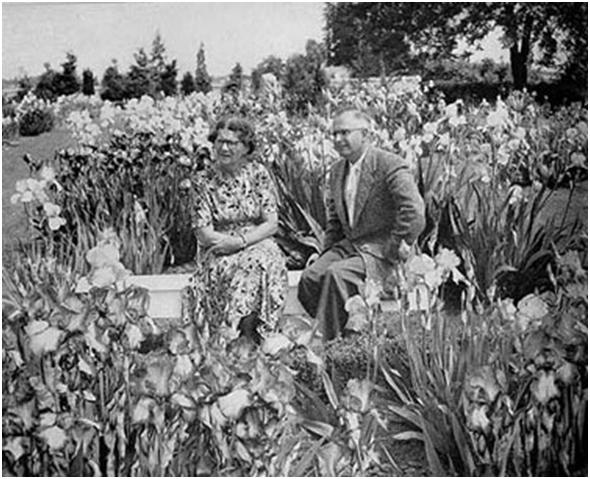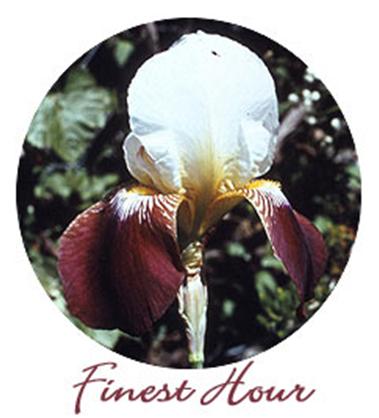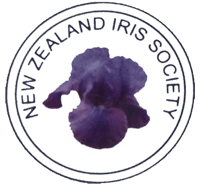Who was Jean Stevens?
Climb to the Pinnacle
Many thanks to the Historic Iris Preservation Society for allowing us to reprint this article.
By W. F. Scott, Jr., Mo.
In 1923 a young New Zealand girl was given a new job, and acquired a new hobby. Her father had been a grower of cut flowers for the wholesale market in New Zealand, and having studied the catalogs issued by R. J. Wallace & Co., of England, he decided that it was time to start growing irises for the New Zealand gardeners. The task of writing his catalog, handling customer’s orders, and growing the irises he gave to his young daughter, Jean. This was a country community with little social activity, and Jean welcomed something which both interested her and occupied her time.

Mrs. Jean Stevens, eminent iris breeder from New Zealand, poses with AIS President Marion Walker in the Schreiner garden, Salem, Oregon, on a recent trip to the states.
The great plants derived from Dominion began to reach New Zealand, and Jean was enthralled. Why could not she create such things as these? Why not try? So she did, but not knowing the sexual parts of the flowers, she was not at first successful. The pollen was easy to find. But where to put it? She guessed the beard was the place, so she rubbed the pollen on it and wondered why no pods were set. Fortunately, Mr. Bliss about that time wrote a paper explaining the parts of the iris flower, and telling how to pollinate the blossom. With this in hand, Jean was ready to start a far-reaching career.
 We, with hundreds of today’s great hybrids all about us, must remember that the only varieties available to a girl in far-off New Zealand in 1923 were those such as Iris King, Rodney, Diadem, Ma Mie, Lady Foster, Dominion, Souv. de Mme. Gaudichau, Lent A. Williamson, Alcazar, Susan Bliss, Seminole, and Cardinal. In 1925, Jean made her first good crosses, and from one of them (Alchazar x Ballerine) came a seedling which was to be the forerunner of many of her later varieties. Jean did not know a diploid from a polyploid, and until 1930 her crosses involved mainly diploids. The resulting seedlings were just average, with two exceptions. One was from (Susan Bliss x Victoria Louise) and had pure white standards with rosy red falls. The falls were heavily striated. This seedling was sterile, but the opaque quality of its standards interested Jean, and set for her a criterion of quality in white standards, which she uses to this day. The other interesting seedling was a small yellow-ground plicata, a diploid, to be sure, but several years before the Sass brothers produced their first large yellow-ground plics. She kept these two, giving the red amoena the name Egmont, and the plic the name Mongrel. In later years she imported Orloff and Seigfried, and was amazed to find that they were simply large “Mongrels.”
We, with hundreds of today’s great hybrids all about us, must remember that the only varieties available to a girl in far-off New Zealand in 1923 were those such as Iris King, Rodney, Diadem, Ma Mie, Lady Foster, Dominion, Souv. de Mme. Gaudichau, Lent A. Williamson, Alcazar, Susan Bliss, Seminole, and Cardinal. In 1925, Jean made her first good crosses, and from one of them (Alchazar x Ballerine) came a seedling which was to be the forerunner of many of her later varieties. Jean did not know a diploid from a polyploid, and until 1930 her crosses involved mainly diploids. The resulting seedlings were just average, with two exceptions. One was from (Susan Bliss x Victoria Louise) and had pure white standards with rosy red falls. The falls were heavily striated. This seedling was sterile, but the opaque quality of its standards interested Jean, and set for her a criterion of quality in white standards, which she uses to this day. The other interesting seedling was a small yellow-ground plicata, a diploid, to be sure, but several years before the Sass brothers produced their first large yellow-ground plics. She kept these two, giving the red amoena the name Egmont, and the plic the name Mongrel. In later years she imported Orloff and Seigfried, and was amazed to find that they were simply large “Mongrels.”
In 1929 Jean flowered a seedling which she named Destiny, and which she sent to Geoffrey Pilkington, in England, for comment. The first year it was shown in England it was awarded the Bronze Medal. Later the Royal Horticultural Society gave it their Award of Merit. In this same period, two other of her varieties received the R.H.S. Award of Merit, Bangatira, and Ruahine. The good R.H.S. judges must have puzzled over the Maori names.
Though halfway around the world from horticultural centers, Jean was by no means “working in the dark,” for she regularly sent her best selections both to Mr. Pilkington and to Mr. G. P. Baker for testing. Later she also sent selections to Mr. R.E.S. Spender, and to Mr. Leslie Cave. These four gentlemen were immensely helpful, and dutifully sent careful and candid observations on all of the seedlings sent them.
Jean joined the British Iris Society in 1927, and the American Iris Society soon afterwards. Later she became a Life Member of both societies. About this time, too, some of her varieties began to be seen in the United States, and then began an association which has prospered for twenty years. From the cross (Pioneer x Seminole) Jean flowered some interesting seedlings. In the F2 of this line she found the seedling she named Inspiration. Mr. Robert Schreiner (then living in Minnesota) saw Inspiration, and wrote Jean asking to purchase some stock of it. The transaction proved to be so satisfactory that Jean soon was sending Mr. Schreiner her best seedlings, which she continues to do to this day.
As her knowledge of iris breeding increased, Jean found her mind constantly returning to that little red amoena which she had named Egmont. By this time she realized how difficult it is to produce good amoenas, for she had done some work with Wabash and had discovered that Wabash, outbred, will not produce amoenas even in the F2. Jean wanted a good tetraploid red amoena. She started with the assumption that Dykes was correct when he postulated that an amoena is simply an albino variegata. She planned to use a yellow-falled amoena to breed to Wabash, and then select and line-breed for red. From literature available, she decided that Ambassadeur must have a large dose of variegata blood in it, and therefore Mrs. Valerie West must also have variegata blood. Though there was no positive proof that Mrs. Valerie West was related to Ambassadeur, the details of appearance of the two plants made this a reasonable deduction. So she planned to use Mrs. Valerie West in her crosses for a red amoena.
For her starting point she selected Shasta, a white of probably I. mesopotamica derivation, and crossed Mrs. Valerie West to it. This cross produced Magnolia, a cream with lines of gold on the hafts, and bearing variegata blood if her original assumptions were correct. At the same time, Jean made a cross of another seedling from Mrs. Valerie West to Lady Morvyth, an English variegata with very pale yellow standards. A seedling of this cross was crossed to Gudrun upon the assumption that Gudrun must have variegata blood arising from the yellow breeding of Dykes. From this series of crosses ((Seedling x Lady Morvyth) x Gudrun) came an unusual white seedling. It was unusual in the peculiar opacity of the standards, and it had fine clear gold reticulations at the haft. Jean retained this seedling and used it in many future crosses, though she never gave it a name. She crossed it to Pilkington’s Lagos, which has cream standards and pale yellow falls. >From this came two seedlings with white standards and primrose-flushed falls. One was weak and was discarded. The other was totally lacking in pollen and could be used only as a seed parent.
On this seedling she used pollen from Magnolia. Now Magnolia produces extremely little pollen, but Jean collected enough to make the cross, most fortunately. This produced a progeny of white and yellow seedlings, one of which was the now famous Pinnacle.
With this portion of the puzzle solved, Jean triumphantly bred Pinnacle to Wabash, and awaited the flowering of red amoenas. Alas, things just do not happen so happily! No red amoenas resulted. However, Jean stuck by her theory that a yellow-falled amoena must always be used with a Wabash-type amoena to produce red amoenas.
Parallel with the other lines, she had been working with Naranja, and from crosses of it with variegata-bred red seedlings she had obtained some interesting results. One of these seedlings was crossed with Pinnacle. From the cross (Russet Mantle x Three Sisters) Jean had a near-amonea. This she crossed to the Pinnacle, Naranja-derived seedling and produced Finest Hour.

So you can see that all of the fine results flowing from the hill above Wanganui have been derived from a mere handful of varieties, plus a tremendous amount of that indefinable sixth-sense which great plant breeders must have. Nine varieties make up most of the source-list; Moonlight, Mrs. Valerie West, Aurelle, Pioneer, Lady Morvyth, Golden Majesty, Shasta, Dark Knight, and Naranja.
This last one is important, for Jean believes that her present pink amoena work is attributable to Naranja. Her first pink-bud break came from Naranja, and though she subsequently used Pink Cameo to some extent, she feels that Naranja is basically responsible for her pinks. In developing her pink amoena line she has used Naranja, Pink Cameo and seedlings from the Pinnacle line.
Pinnacle derivitives have also been used in her brown amoena line. First she obtained two-toned golds from Gold Sovereign crossed to yellow amoenas, particularly Summit. Then the Pinnacle line was diffused by crosses with deeper golds, until the falls became brown.
All this time the standards must be kept clean and opaque! Jean has accomplished this by rigorous selection. Haft venation is so dominant that she feels it is useless to proceed with a rough seedling, no mattter how promising may be its other qualities. She has sacrificed excellent seedlings because of rough hafts, and has used instead seemingly inferior siblings having clean hafts. She has selected on the basis of “standards first,” concentrating on them, watching to see that color does not creep up from the base. She has never used a seedling upon the basis of parentage alone. Most of the characters she seeks are so exceedingly recessive that if a seedling does not visually exhibit the desired character to some extent, it is a waste of time to use it, at least past the F2.
One of Jean’s most critical coments on current American varieties is the indifferent branching. Many American breeders have sacrificed branching in favor of color, or size, or ruffling. Jean feels that no one cross is worthwhile if both parents have inferior branching. If she must use a short-branched seedling in a cross, she makes certain that the other parent is very wide-branched. She critically counts the buds in each socket, and is exceedingly harsh in judging her own seedlings. “Of what good,” she asks, “is any iris plant with only seven to nine blossoms?” Twelve should be minimum.
Though most of her work and fame are connected with Tall Bearded varieties, she grows and works with an amazing assortment of other species. Nearly twenty years ago she did a great deal of work with i. innominata, and about ten years ago she sent some seedlings from this work to Dr. Lee Lenz. He was amazed at the size and quality of them. Only in the past few years has anything approaching them been created here. She also produced and introduced a hybrid of I. wattii x I. tectorum which she named Queen’s Grace. And she made the first cross between the two very rare xiphion species I. juncea x I. boissieri. The hybrids resulting from this most unusual cross are intermediate between the two parents, most of them being bronze and bronze-purple. Amidst all this work she found time to get married, in 1935, to Wally Stevens, as delightful a screw-ball as you’ll ever meet. If you have the pleasure of visiting with Wally, keep your sense of humor well polished, and your ears widely cocked, for he is chock-full of a sneaky sort of humor which creeps up on your blind side, and leaves you wondering minutes later just what happened. Then you turn your head, and there’s Wally, looking innocent, but with a sly twinkle in his eye. And you know you’ve been well kidded.
Wally is also an expert plantsman, and a collector of rare and spectacular things, mostly from South Africa and Australia. The steeper portions of Bastia Hill are covered with things like Leucospermum Bolusii, Eucalyptus Lehmanii, Banksia Caleyi, Leucospermum Catherinae, Leucospermum reflexum, Protea cyanaroides, and Craspedia globosa. Exotic names to us, and exotic flowers anywhere.
To sit and talk with these two, over coffee and cake, is an unforgettable experience. The breadth of knowledge they have of plant and animal life all over the world is astounding. You find yourself muttering, “No wonder. No wonder she can create such wonderful irises. Goodness, she has forgotten things most plant breeders never learn!” But don’t fool yourself, she has not forgotten anything.
She will sit sipping her coffee, with a far-away look in her eyes, planning how she is going to create that long-hunted red iris. And she knows exactly how it is to be found, too.
Would you like to know the secret? Would you like to be the first? Jean will tell you, cheerfully. For she wants to help others, and gives freely of her knowledge to all who ask. Here is how to create a red iris: Jean assumes several things, and her assumptions have been very accurate in the past. Our present “red” irises combine the comparatively light yellows of the past with purple anthocyanin. Things like Mary Randall prove that anthocyanin plus sufficient dosage of the pink-bud factor will produce a very vivid purple. Visually, this is t-factor plus anthocyanin. Really gold color plus t-factor gives things like Top Flight. Combine the two (Mary Randall-type purple and Top Flight-type color) and the result should equal bright red. You have anthocyanin plus t-factor, and Top Flight-color plus t-factor, which added together should visually result in red. Try it! Jean intends to do so.
This, then, is Jean Stevens, the woman who lives on a high hill overlooking the Tasman Sea, but who is known and loved throughout the world. May her years be long!
Reprinted from an AIS Bulletin No 152 (Jan 1959)
Many thanks to the Historic Iris Preservation Society for allowing us to reprint this article.
Follow The Links Below For Related Jean Stevens Articles
